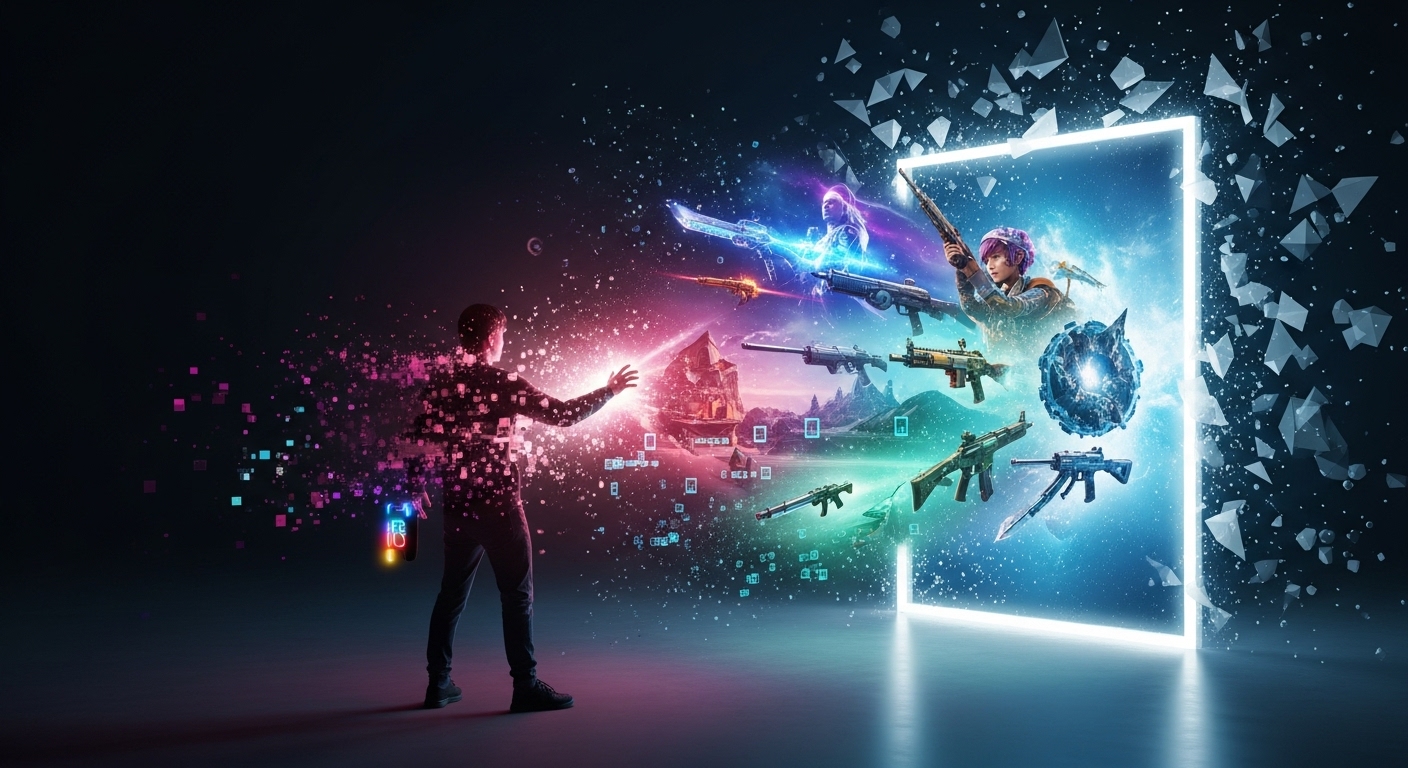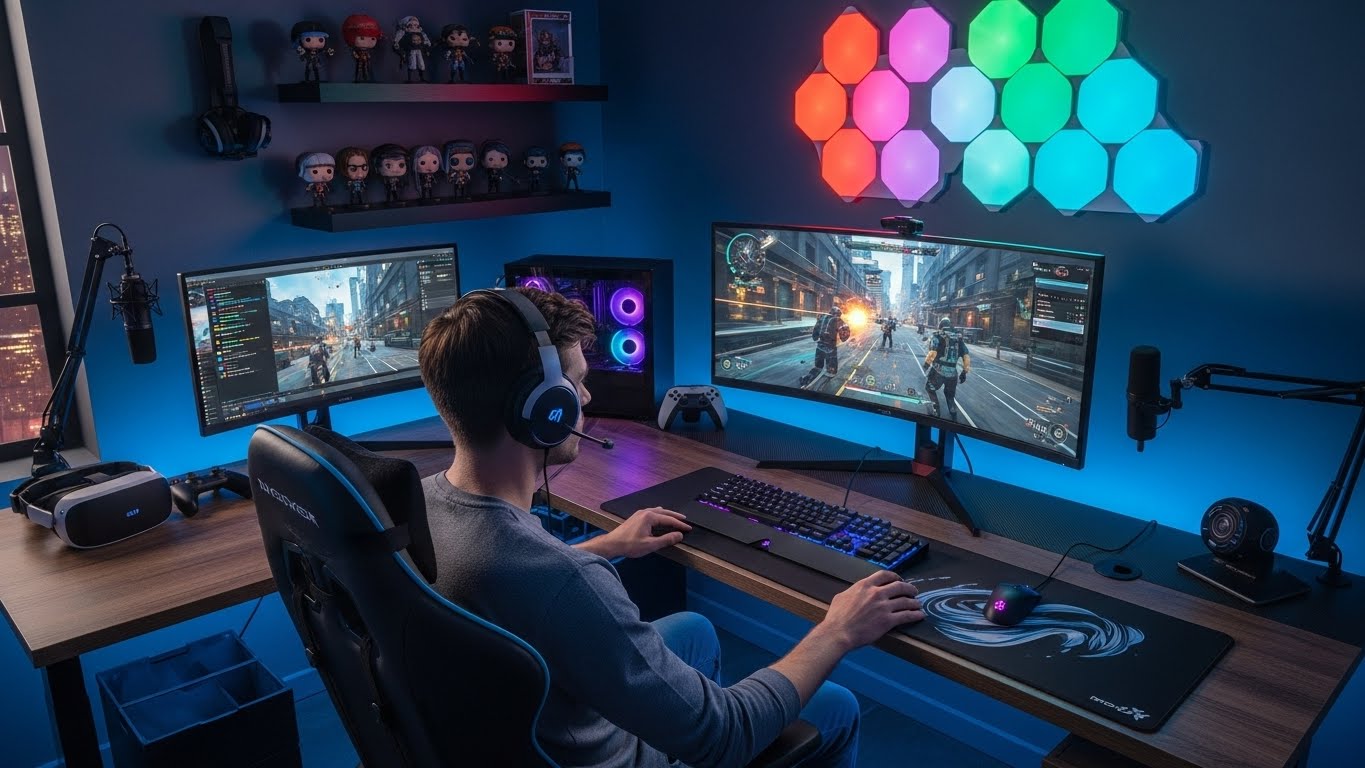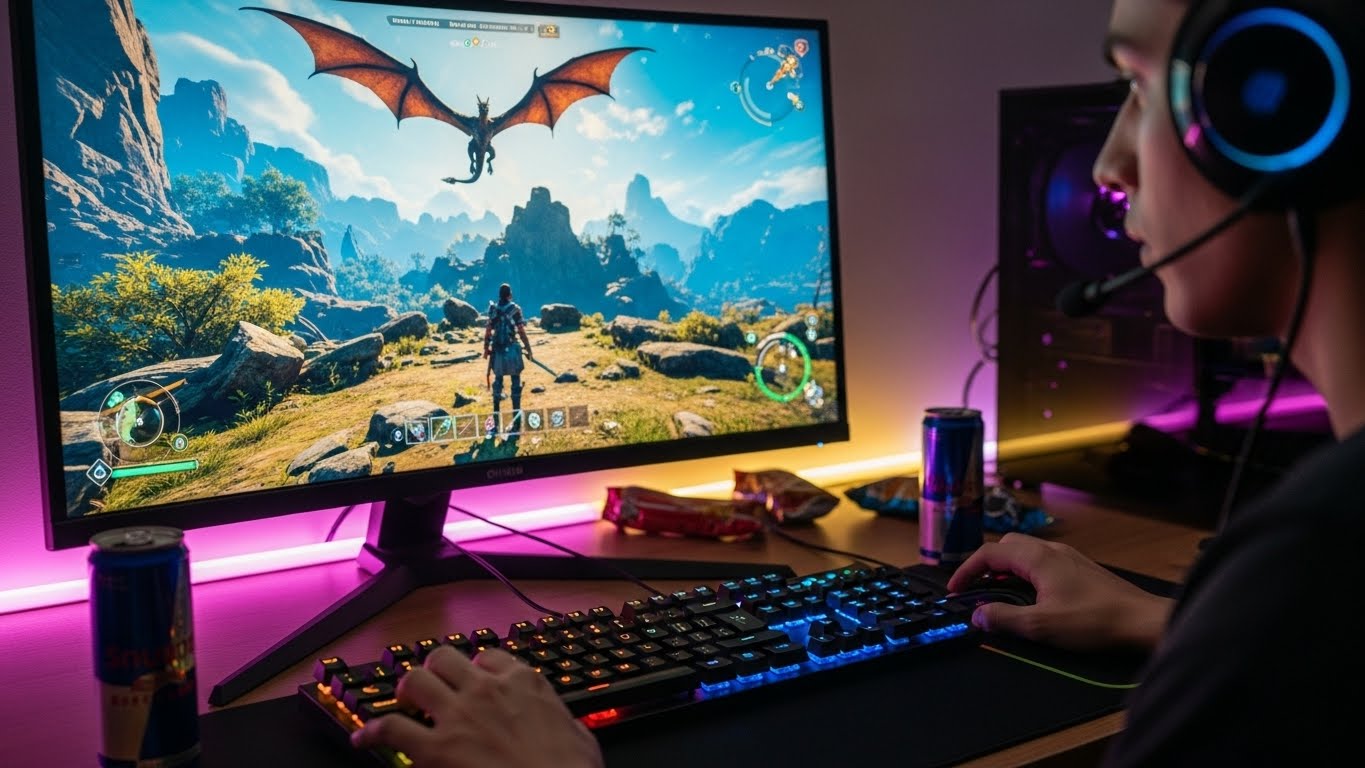Introduction: The Power of Play
Gaming is no longer just a pastime; it is a global phenomenon that connects billions of people across different cultures, languages, and generations. What began as simple pixels moving across a screen has evolved into a vast, multi-dimensional universe filled with art, storytelling, competition, and community. Whether it’s an immersive open-world adventure, a strategic online match, or a nostalgic retro classic, gaming has cemented itself as one of the most influential forms of entertainment in modern history.
This blog explores the journey of gaming — from its humble beginnings to its current form as a dominant cultural force — and speculates on what lies ahead for the industry and its global audience.
The Birth of an Industry: Early Days of Gaming
The roots of gaming can be traced back to the 1950s and 1960s, when scientists and computer engineers began experimenting with interactive digital entertainment. The first known video game, Tennis for Two, was developed in 1958 by physicist William Higinbotham. It was a simple tennis simulation displayed on an oscilloscope, but it laid the foundation for what would become a new form of play.
The 1970s brought the first wave of arcade machines and home consoles. Games like Pong and Space Invaders introduced the idea of competitive high scores and social gaming spaces. The Atari 2600, released in 1977, brought gaming into homes around the world, allowing people to experience digital entertainment without leaving their living rooms.
Though these early games were primitive by today’s standards, they captured imaginations and demonstrated the power of interactive media. For the first time, people weren’t just watching stories unfold — they were a part of them.
The Golden Age of Gaming: The 1980s Explosion
The 1980s marked the first golden era of gaming. Arcade halls were packed with machines featuring colorful graphics, catchy music, and addictive gameplay loops. Titles like Pac-Man, Donkey Kong, and Galaga became cultural icons, and competitive gaming started to emerge as friends compared high scores and bragging rights.
At the same time, home consoles began to grow more sophisticated. Nintendo’s arrival on the scene revolutionized the industry. The release of the Nintendo Entertainment System (NES) in 1985 brought structured game design, story-driven adventures, and beloved franchises like Super Mario Bros., The Legend of Zelda, and Metroid. Sega also entered the arena with its own consoles, sparking the first great console rivalry.
PC gaming also started to gain traction, with early titles like King’s Quest and Ultima introducing deep narratives and exploration. The seeds of genres like role-playing games (RPGs) and strategy were planted during this era.
The 1980s proved that gaming was more than a fad — it was an art form and an industry poised for exponential growth.
The Rise of 3D Worlds: 1990s Innovation
The 1990s ushered in a technological revolution. The leap from 2D sprites to 3D polygons changed everything. This decade saw the birth of fully realized virtual worlds that players could explore in three dimensions. Sony entered the gaming scene with the PlayStation, and alongside Nintendo 64 and Sega Saturn, a new era began.
Games like Super Mario 64, The Legend of Zelda: Ocarina of Time, and Final Fantasy VII demonstrated the storytelling potential of interactive entertainment. These titles were not just about fun; they carried emotional weight and cinematic depth. Meanwhile, PC gaming flourished with titles like StarCraft, Half-Life, and The Sims, which expanded the definition of what gaming could be.
The 1990s also saw the beginnings of online gaming. With the rise of the internet, players could now connect across long distances. Early online titles like Quake and Ultima Online laid the groundwork for the connected multiplayer experiences we take for granted today.
The 2000s: The Era of Connectivity
The 2000s brought about a major transformation in the gaming landscape — the rise of connected gaming. Consoles like the PlayStation 2, Xbox, and later the Xbox 360 and PlayStation 3, made online multiplayer mainstream. Services such as Xbox Live allowed players to compete, communicate, and build communities in ways that were previously impossible.
Massively Multiplayer Online Role-Playing Games (MMORPGs) like World of Warcraft became cultural phenomena, attracting millions of players into shared fantasy worlds that never slept. The concept of digital identity began to form — gamers weren’t just players; they were avatars, guild leaders, strategists, and storytellers.
The 2000s also brought technical leaps in graphics, physics, and narrative design. Developers pushed boundaries with cinematic storytelling, seen in games like Metal Gear Solid 3, Halo 2, and The Elder Scrolls IV: Oblivion. The line between movies and games began to blur.
Handheld gaming also evolved through devices like the Nintendo DS and Sony PSP, making it possible to play console-quality games on the go. Gaming had officially become an integral part of global culture.
The 2010s: The Age of Streaming and Esports
The 2010s were perhaps the most transformative decade in gaming history. Not only did games become bigger and more beautiful, but the way we consumed gaming also changed entirely.
Platforms like Twitch and YouTube allowed anyone to share their gameplay experiences with the world. Gaming became a spectator sport, and personalities like streamers and content creators emerged as celebrities in their own right. This shift redefined what it meant to participate in gaming culture — one didn’t even need to play to be a fan.
At the same time, esports exploded into mainstream consciousness. Competitive titles like League of Legends, Dota 2, Counter-Strike: Global Offensive, and Overwatch drew millions of viewers and offered prize pools in the millions. Gaming tournaments began filling arenas once reserved for traditional sports.
The indie game revolution also flourished during this decade. Small teams and solo developers, empowered by digital distribution platforms, began creating innovative, emotional, and artistically rich games such as Undertale, Celeste, and Hollow Knight. These titles proved that creativity and storytelling could thrive outside big-budget studios.
The Modern Era: Immersion, Diversity, and Accessibility
Today, gaming has reached unprecedented levels of sophistication and inclusivity. The latest generation of consoles, such as the PlayStation 5 and Xbox Series X, delivers lifelike graphics, near-instant loading, and seamless online integration. PC gaming continues to push the limits of hardware performance, while mobile gaming dominates in sheer player numbers worldwide.
Virtual reality (VR) and augmented reality (AR) have opened new frontiers in immersion. Players can now step into digital worlds, interact with virtual environments, and experience games with a level of realism that once belonged to science fiction. Titles like Half-Life: Alyx demonstrate the immense potential of VR storytelling.
Another defining trait of the modern gaming landscape is diversity. Representation has improved across characters, stories, and players themselves. Gaming communities have grown more inclusive, advocating for accessibility features and creating spaces for everyone to play. Developers now prioritize customizable controls, subtitles, colorblind modes, and adaptive technologies to ensure that gaming is truly for all.
The Social Impact of Gaming
Beyond entertainment, gaming has become a powerful social and cultural force. Online games function as digital meeting grounds where people from across the world can communicate, collaborate, and compete. Friendships are formed in virtual worlds, and communities flourish around shared experiences.
During global events such as the pandemic, gaming played a crucial role in connecting people. Titles like Animal Crossing: New Horizons became digital safe havens, offering comfort and companionship in times of isolation.
Gaming has also proven its educational and therapeutic potential. Studies show that video games can improve problem-solving skills, coordination, and even emotional resilience. Serious games are used in classrooms to teach subjects like history, science, and language in engaging, interactive ways. In the field of healthcare, gamified therapies help patients with physical rehabilitation and mental health management.
The Art of Storytelling in Games
One of the most profound evolutions in gaming has been its transformation into a storytelling medium. Modern video games are capable of delivering emotional depth, moral complexity, and narrative intricacy rivaling that of books and films.
Titles like The Last of Us, Red Dead Redemption 2, and God of War show how interactive storytelling can create deeply personal connections between player and character. Players make choices that shape outcomes, giving them agency and emotional investment in ways that passive media cannot replicate.
Games also explore philosophical and ethical questions — about humanity, technology, power, and consequence. Through branching narratives and player choice, gaming allows us to explore who we are and what we value.
The Business of Gaming
The gaming industry has grown into one of the largest entertainment sectors in the world, surpassing film and music combined in revenue. Major companies invest billions in development, marketing, and distribution. Yet, alongside corporate giants, independent developers continue to innovate and push creative boundaries.
The monetization models have evolved significantly — from one-time purchases to downloadable content (DLC), subscriptions, and live-service economies. Free-to-play games like Fortnite and Genshin Impact have proven that success doesn’t always require an upfront price tag. Instead, in-game cosmetics, battle passes, and virtual currencies drive sustained engagement and profitability.
Meanwhile, the conversation about fair monetization, player rights, and ethical game design continues to shape industry practices. Players are more informed and vocal than ever, influencing the direction of game development through feedback, reviews, and online discourse.
Gaming Communities and Culture
Gaming culture is as diverse as the people who inhabit it. From speedrunners who complete games in record times to modders who create new content, from casual players to hardcore competitors, the gaming community is a tapestry of passion and creativity.
Fan art, cosplay, and fanfiction are integral aspects of gaming culture, showcasing how games inspire self-expression and artistic interpretation. Conventions and expos such as gaming festivals bring fans together to celebrate their shared love of play.
However, the community is not without challenges. Issues like toxicity, harassment, and gatekeeping persist in some online spaces. Yet, countless initiatives are working to make gaming more positive, inclusive, and respectful. The ongoing dialogue around mental health, representation, and player well-being is making the culture stronger and more empathetic.
The Future of Gaming: What Lies Ahead
As technology continues to evolve, so too will the possibilities for gaming. Artificial intelligence is poised to revolutionize game design by creating smarter NPCs, adaptive worlds, and personalized experiences. Procedural generation, already seen in games like Minecraft and No Man’s Sky, may one day create entire universes that feel alive and unpredictable.
Cloud gaming is another frontier — allowing players to stream high-end games without needing powerful hardware. This could democratize gaming further, making high-quality experiences accessible to anyone with a stable internet connection.
The integration of haptic feedback, brain-computer interfaces, and even scent and temperature simulation may eventually blur the line between reality and digital immersion. As gaming expands into the metaverse — interconnected virtual spaces where players can socialize, create, and play — we may witness the next great leap in human interaction.
Conclusion: The Endless Game
Gaming has traveled an incredible journey from simple beeps and pixels to vast, living worlds that captivate hearts and minds. It has become a defining art form of the modern era — one that merges technology, creativity, and human connection. It entertains, inspires, teaches, and heals. Most importantly, it unites.
The future of gaming holds infinite potential. As long as humans continue to dream, innovate, and seek connection through play, gaming will continue to evolve — not just as an industry, but as a shared cultural heartbeat.
Because in the end, gaming is not just about winning or losing. It’s about exploration, imagination, and the joy of being part of something bigger than yourself.
The game never truly ends — it just evolves, waiting for the next player to press Start.



